Korean soy marinated raw crab or ‘ganjang gejang‘ is the king of all rice thief dishes. The term ‘rice thief’ or ‘bap doduk‘ [밥도둑] is a term commonly used in Korea for dishes that are so flavorful, that you’ll be compelled to eat more rice than you normally do. And let me preface this by saying, you’ll definitely want to make extra rice for this recipe!
‘Ganjang gejang’ or soy marinated raw crab is a Korean delicacy made of raw crabs that are cured in an umami-packed delicious soy sauce-based marinade. The tender yet subtly sweet meat of the crab is beautifully complemented by the rich and savory flavors of the marinade, making it irresistibly delicious. It’s a dish that I crave time and time again, and once you have a taste of this, I know you will too!
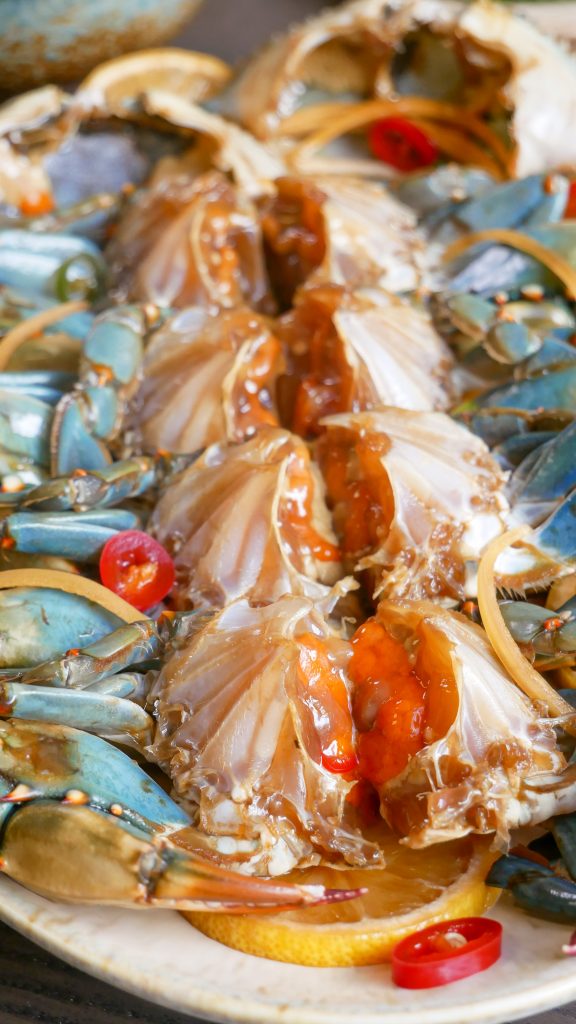
Why you’ll love this recipe
I’m going to be real honest here – this dish is a labor of love but the hardest part about about this recipe is waiting for the crab to marinate. As the saying goes, ‘good things come to those who wait’ and it has never been more true. Once you take a bite of the soft succulent crab that’s been infused with the savory, slightly sweet, and complex flavors of the soy marinade, you’ll understand the craze around this popular dish. And if you’re already familiar with ganjang gejang, well, you already know what the deal is!
To impart more flavor and introduce a contrasting texture, I’ve added sliced peppers, onions, and lemon in the container with the crab before pouring in the marinade. While the lemon is used to subtly brighten up the marinade, the peppers and onions add a hint of freshness. It also slightly pickles during the marinating process, and pair deliciously with the raw crab.
Now since this recipe is made 24 hours in advance, this dish makes for a great quick and easy meal. It’s served chilled so all you’ll need to do is plate up and prepare freshly cooked rice!
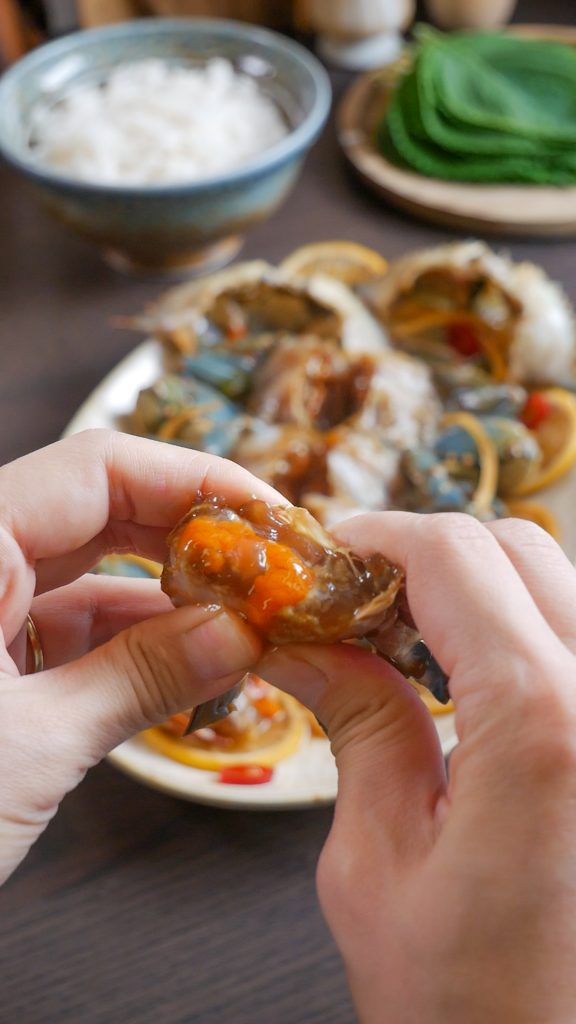

Soy Marinated Raw Crab Ingredients & Substitutions
Live blue crabs: live blue crabs will result in the best flavor and texture. When selecting the crabs, you want to pick ones that have orange-colored claw tips and are lively. Crabs with orange-colored claw tips are female crabs and will usually have roe. Male crabs will have blue-colored claw tips. Avoid sluggish crabs – this usually means they’re not fresh. You can also use frozen crabs called ‘flower crabs’ or ‘kkotge’ (꽃게). The meat is significantly softer than live blue crabs.
Soju – the soju is used to eliminate any underlying oceany odors from the crab. It can be substituted with sake, mirin, or cooking wine. You can also skip this.
Soy sauce – since soy sauce is the base of the marinade, you want to use a high-quality soy sauce. I recommend the Sempio brand.
Mirin – mirin adds a subtle sweetness to the marinade. You can substitute this with sake or soju.
Oligodang syrup – this is a Korean rice syrup that is less sweet than other sweeteners. After several rounds of recipe testing, I found that this tasted the best. However, you can substitute it with sugar or honey.
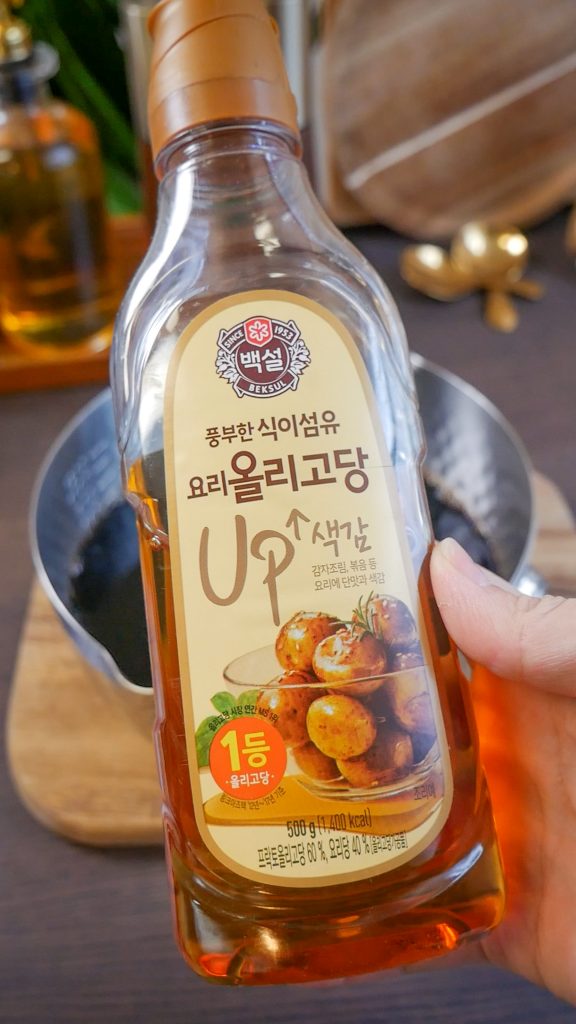
Apple – the apple adds a hint of sweetness and tartness to the marinade. I like using honey crisp apples but you can use any apple you prefer!
Onion – the onion is used in two ways in this recipe. It’s simmered with the marinade to add a hint of sweetness and complexity. It’s also thinly sliced to be used as a garnish.
Scallion – the scallion also helps to develop the flavor of the soy marinade.
Garlic cloves – feel free to add more garlic, but not less!
Ginger – While you won’t taste the ginger in the marinade, it will help to deepen the flavors of the marinade. A little goes a long way!
Cheongyang Pepper – this is a Korean green hot pepper that is usually available at H Mart. This can be substituted with jalapeno peppers or serrano peppers.
Dried red chili peppers – these dried peppers add a slightly smoky and rich flavor to the marinade.
Whole black peppercorns – whole black peppercorns add a subtle sharp and warm aroma to the marinade.
Dried kelp – also known as ‘kombu’, dried kelp adds umami to the marinade. This is an essential ingredient and should not be replaced or omitted!
Water – water is added to the marinate to balance out the savoriness.
Red chili pepper – this is used for garnish primarily for color. I used Holland red peppers which can be found at H Mart however any red pepper would do. Alternatively, you can omit this but I don’t recommend replacing this with cheongyang pepper because it’ll get too spicy.
Lemon – lemon is used as a garnish and helps to brighten the marinade. It’s subtle but I think makes a big difference!
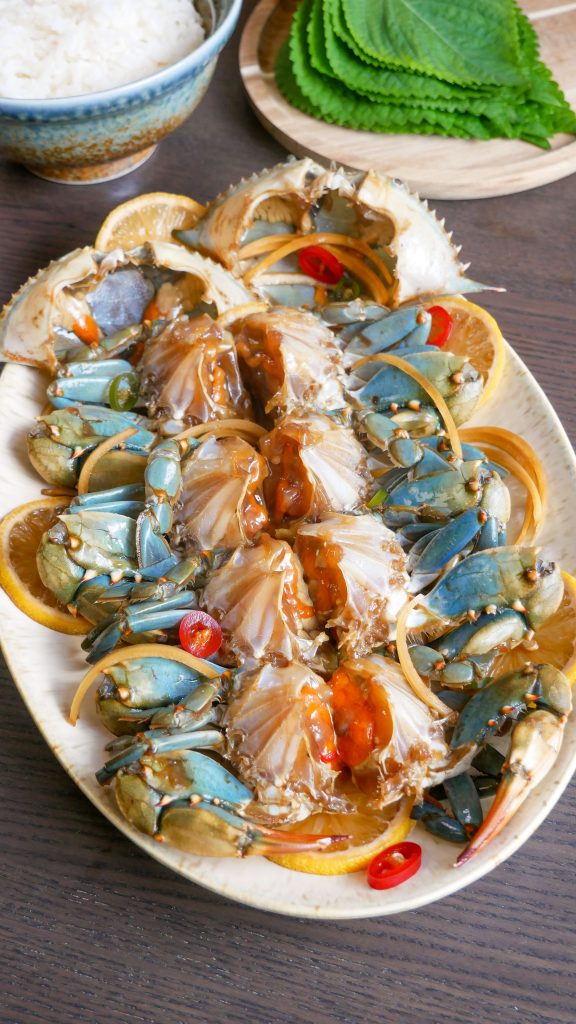
How to Prepare Soy Marinated Raw Crab?
Step 1: Put the crabs to sleep
Live crabs are going to be a pain to deal with and putting them to sleep will make prepping easier. Put the live blue crabs to sleep by placing them into the freezer for 2 to 3 hours or until they’ve completely stopped moving. DO NOT freeze them any longer otherwise it will kill them. Dead crabs will begin decomposing and release bacteria that can cause you to fall ill.
Step 2: Prepare the marinade
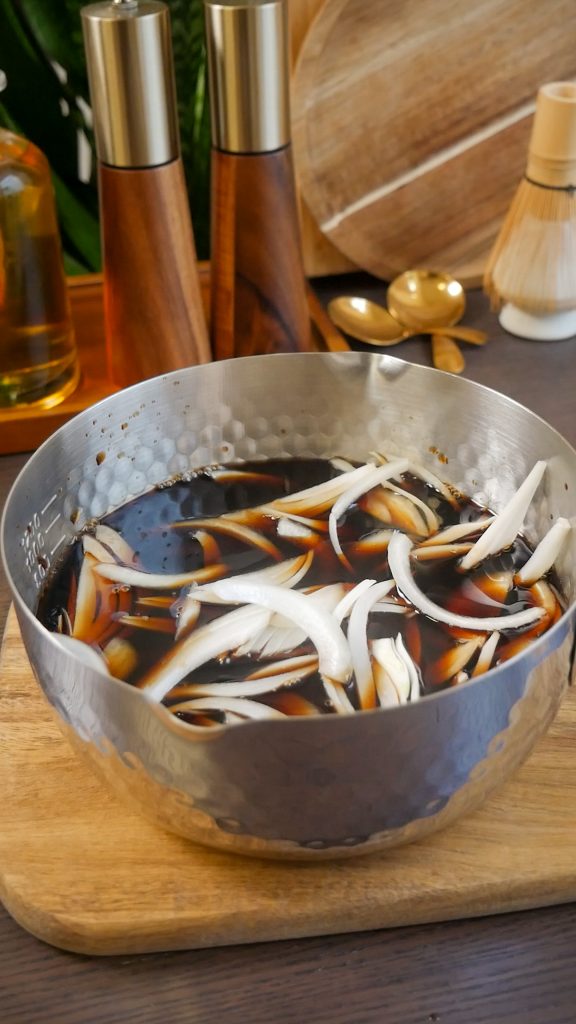
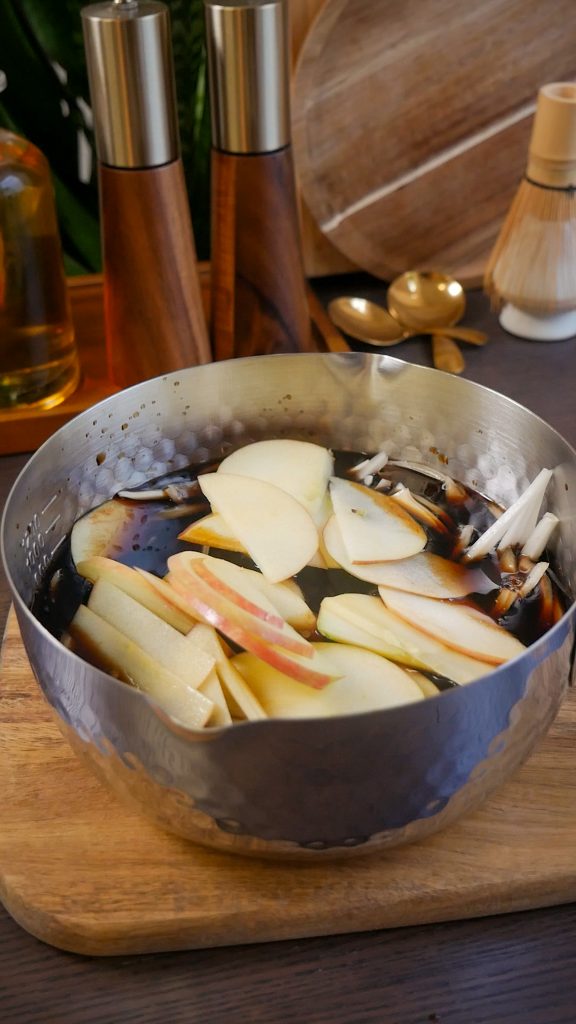
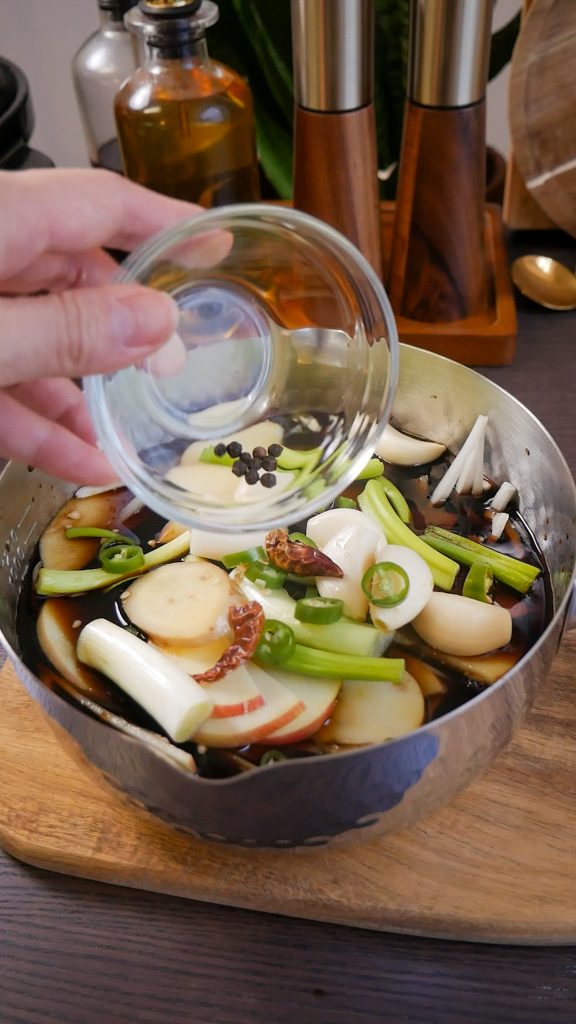
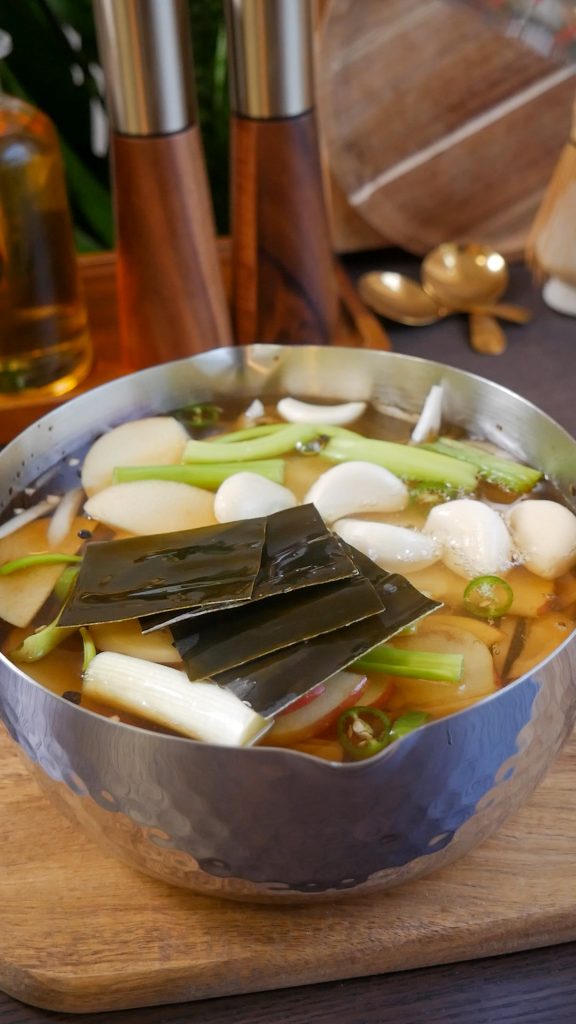
In the meantime, prepare the marinade. In a medium-sized pot, combine soy sauce, mirin, oligodang syrup, apple, onion, scallion, garlic cloves, ginger, cheongyang pepper, dried red chili peppers, whole black peppercorns, dried kelp, and water.


Bring to a boil over high heat then reduce the heat to medium. Simmer for 30 minutes then remove from the heat to cool completely. Once the marinade has cooled, strain then set it aside.
Step 3: Clean the crabs

To clean and process the crab, flip the crab so the underside is facing up. Pull the apron back then twist it to remove it. Rinse the crab under cold running water then use a soft bristle brush to scrub away any dirt and debris. Due to the nature of the crab’s environment, they’re quite dirty so make sure to get into the crevices and thoroughly scrub as best as you can (including the legs!).
Step 4: Prep the crabs
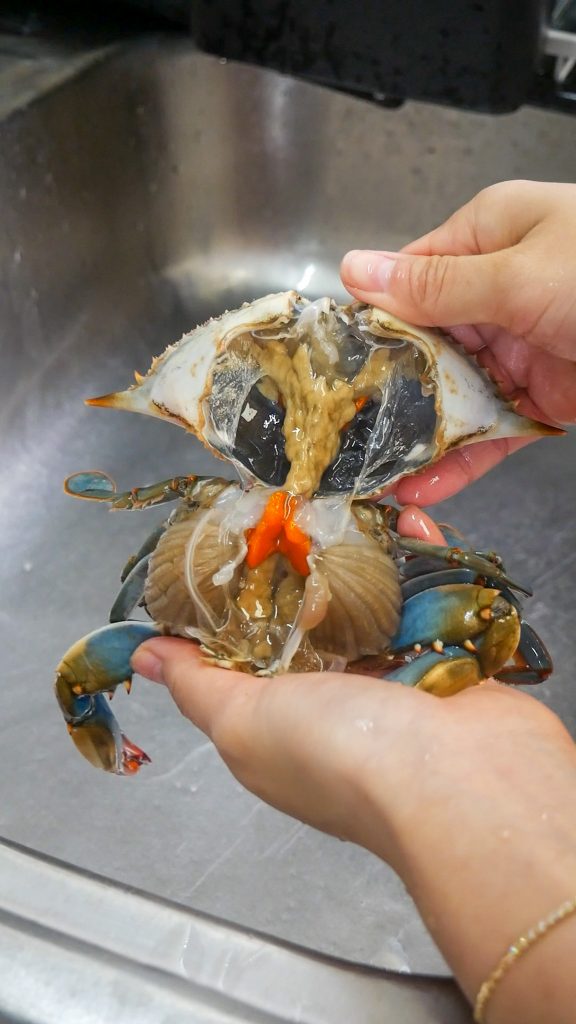
With the crab upright and facing you, place the non-dominant hand on one side of the legs and use the dominant hand to pull back the shell. Don’t toss the shell – we’ll come back to this.

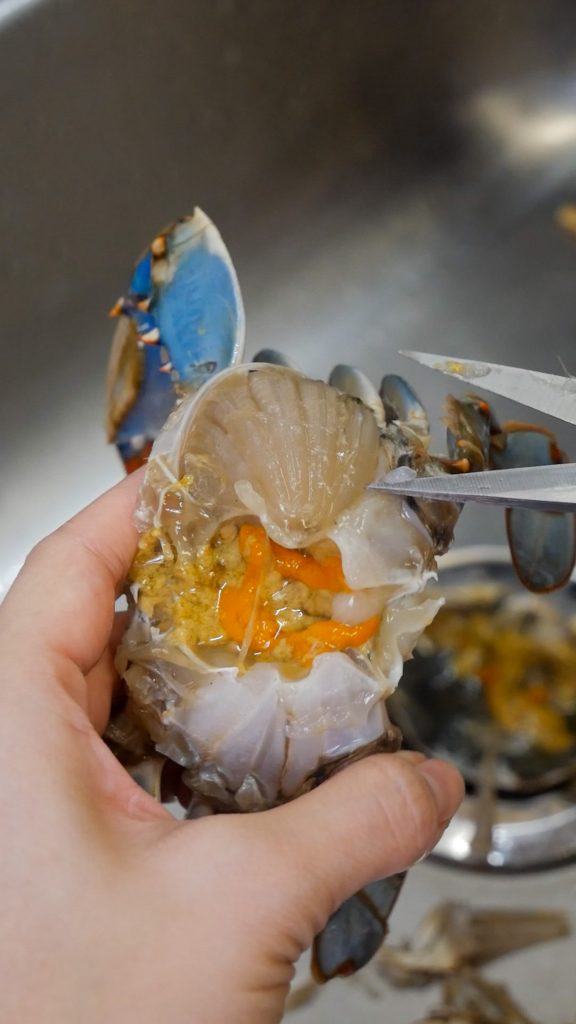
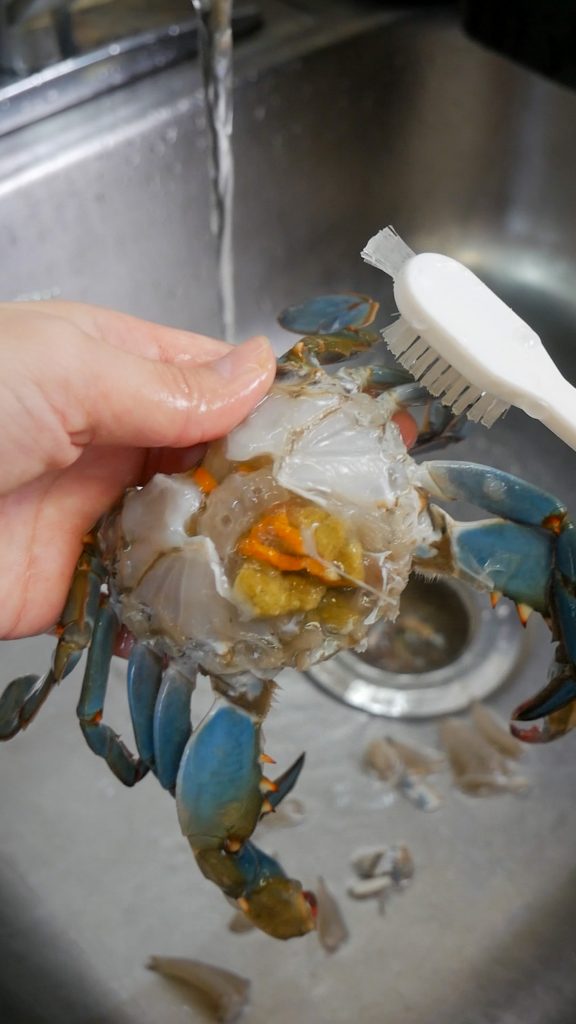
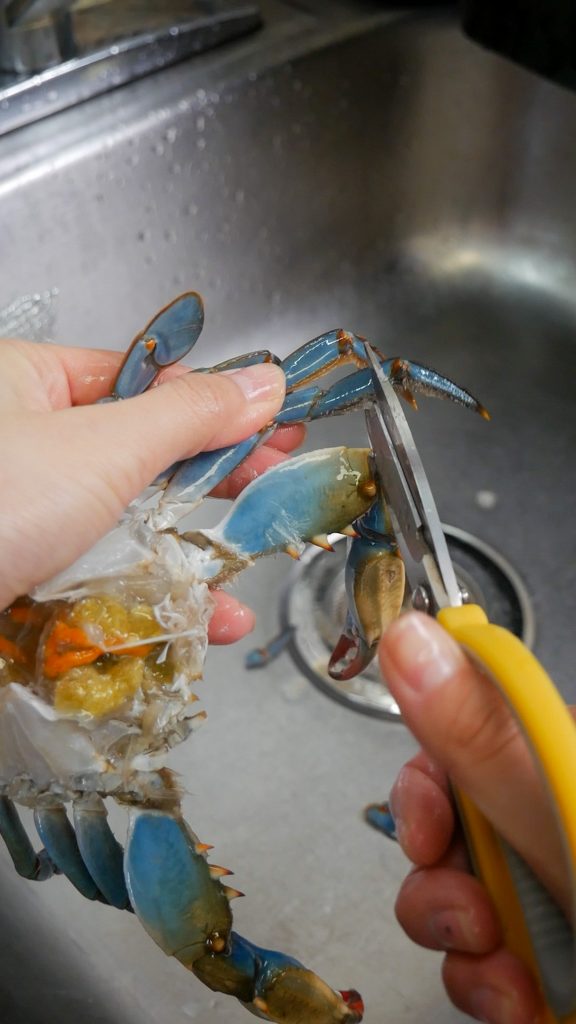
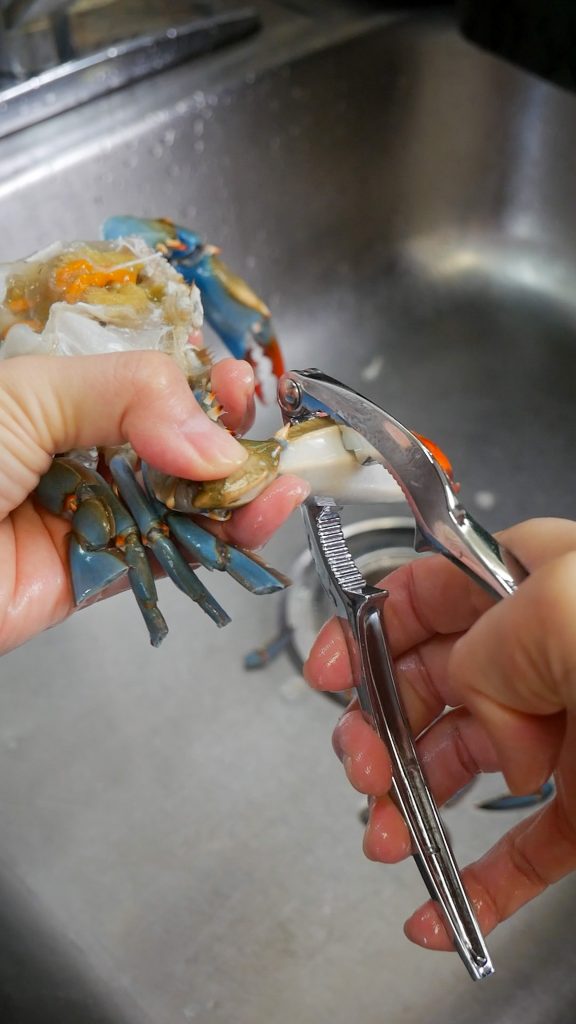
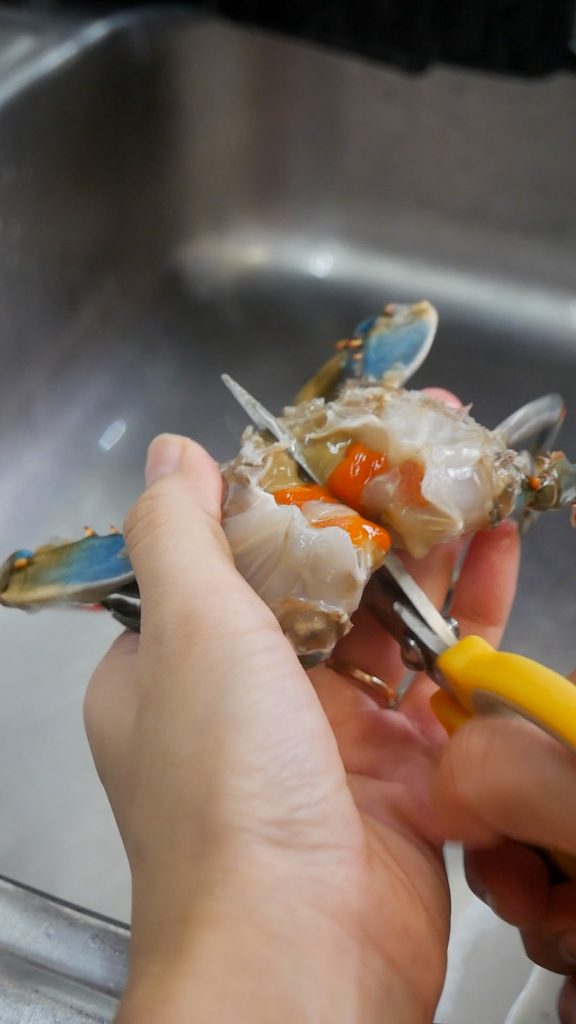

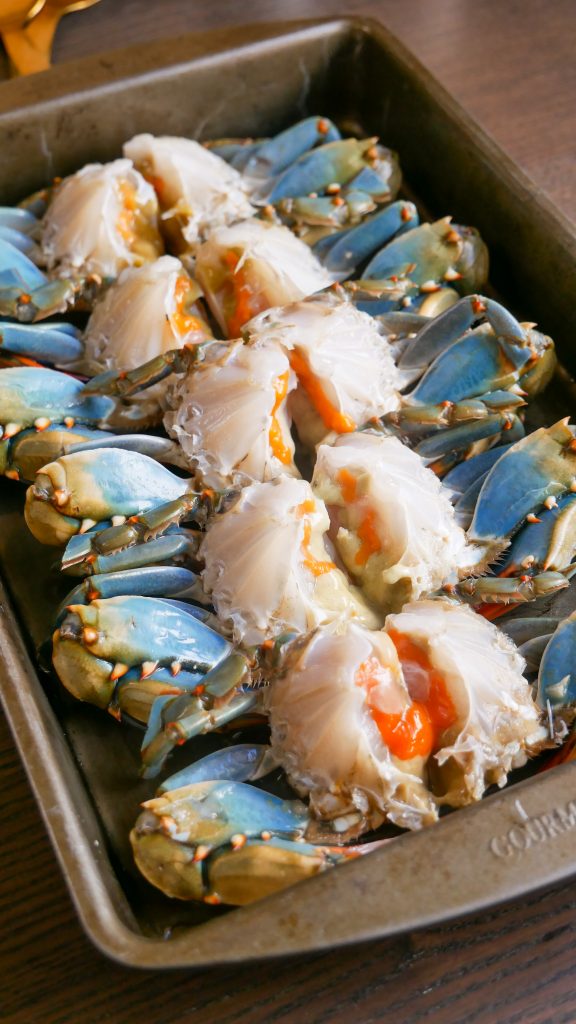
Using kitchen shears, trim away the gills, mouth, and tips of the legs. The claws have a generous amount of meat so don’t let them go to waste! Use a crab cracker to crack the legs which will allow the marinade to seep in. Once cleaned, cut the crab in half down the middle then repeat for the remaining crab.
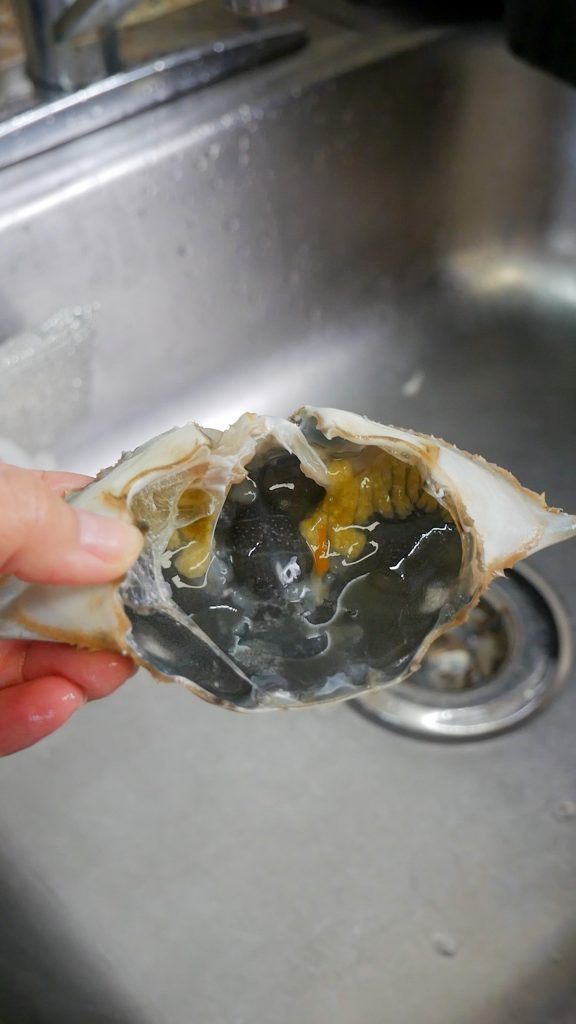
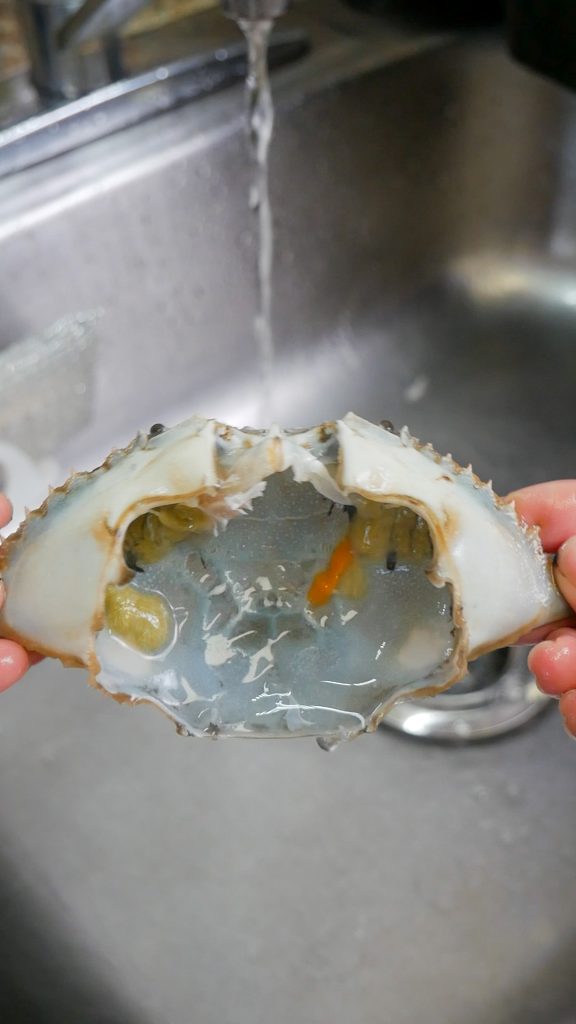
Take the crab shell and peel/scrape away the black film with your fingers. Be sure not to peel away the crab fat or roe – it’s the best part!
Step 5: Soak in soju
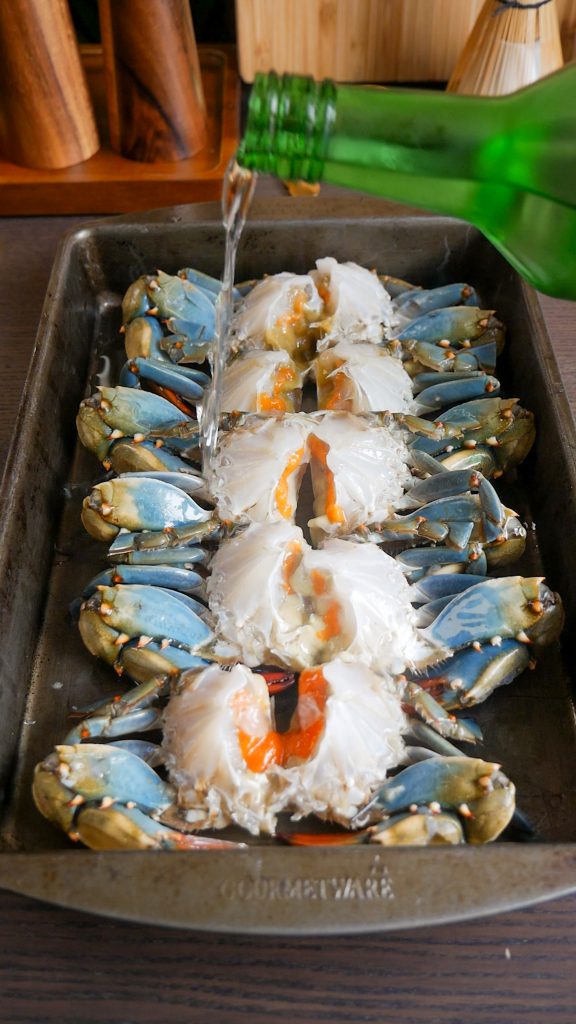
Place the crab in a deep tray or bowl then soak in soju for 10 to 15 minutes.
Step 6: Marinate the crab
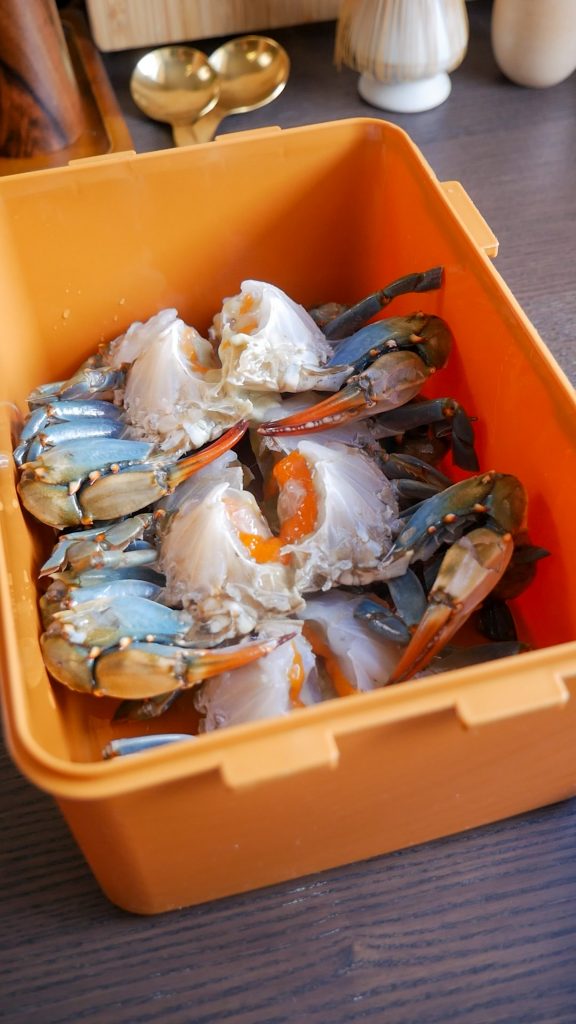

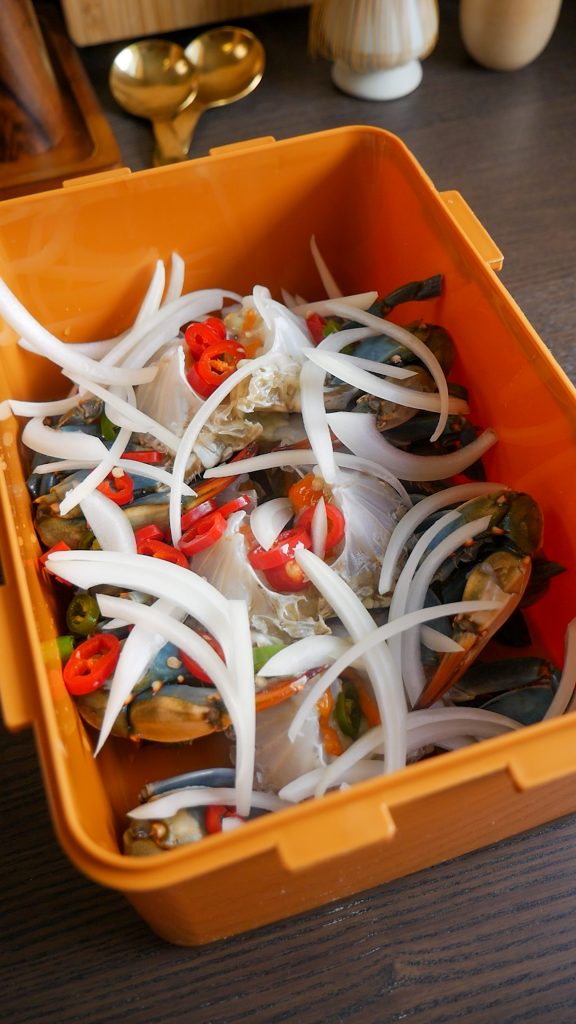
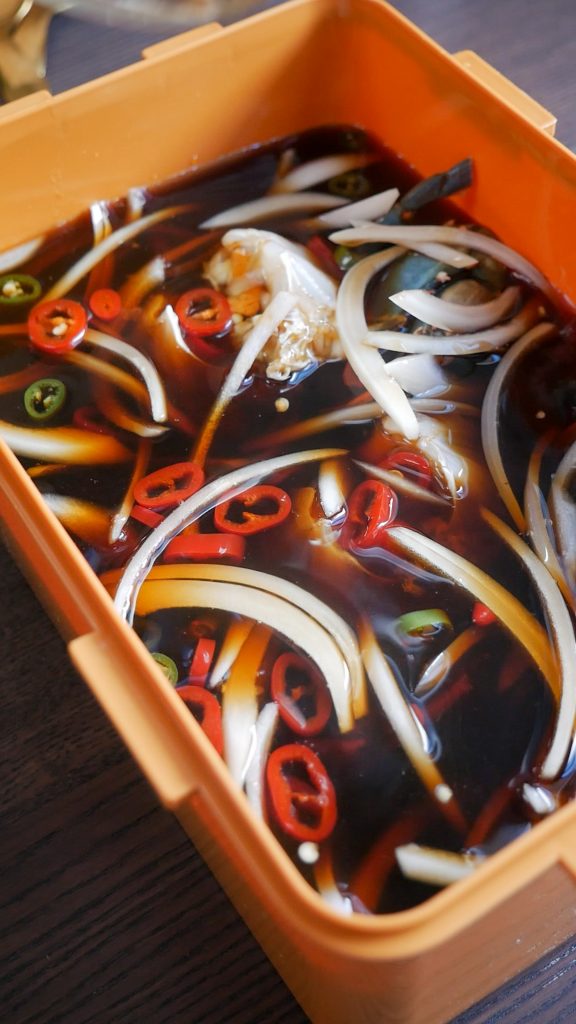
Arrange the crab in a container with an air-tight lid. Top with the garnishes – cheongyang pepper, red chili pepper, onion, and lemon. Pour the chilled marinade over the crab until completely submerged. Place the crab shells upright, making sure they’re submerged as well.
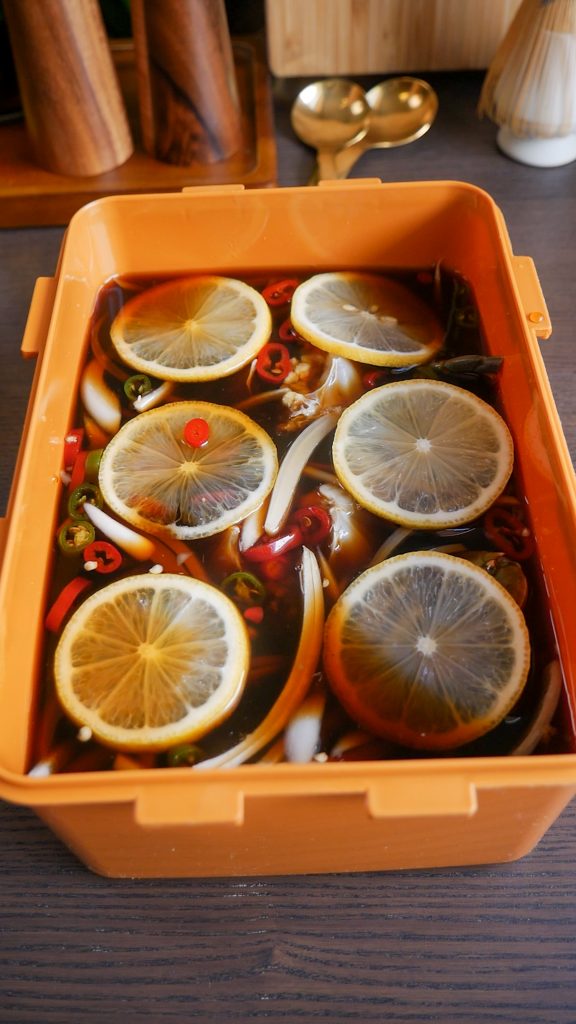

Cover with an air-tight lid then transfer to the fridge. Marinate for at least 24 hours or up to 48 hours.
Step 7: Serve!
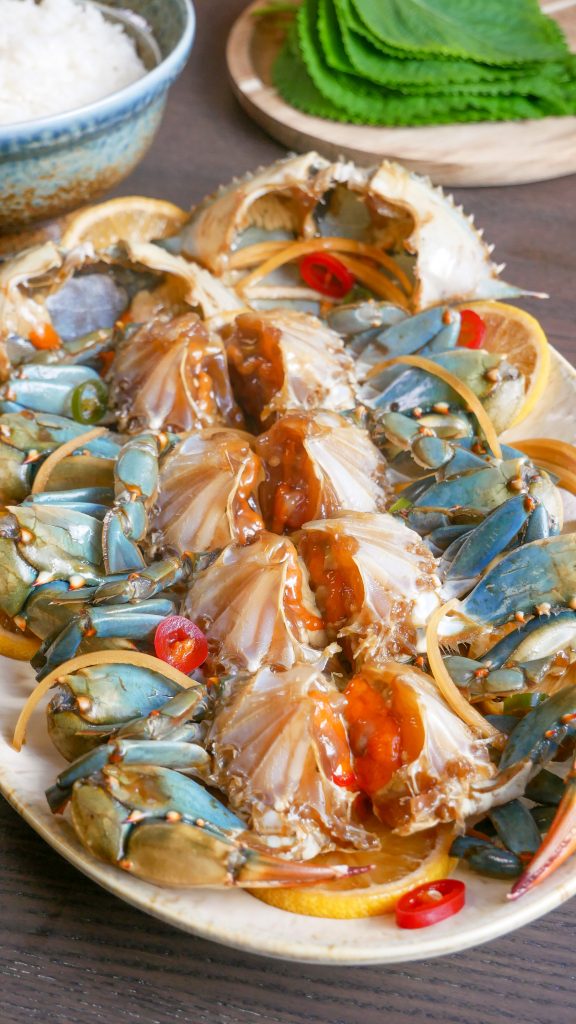
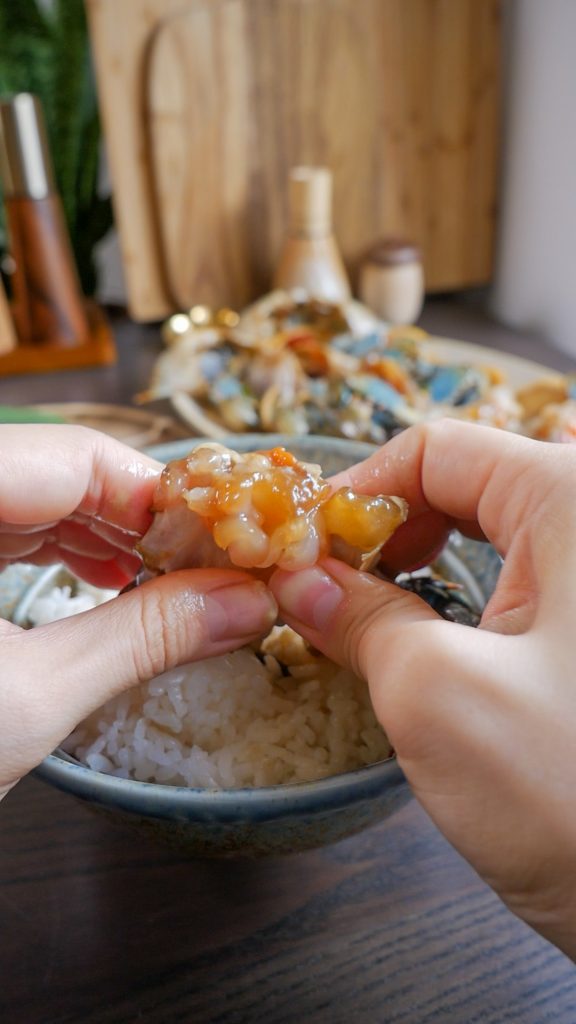
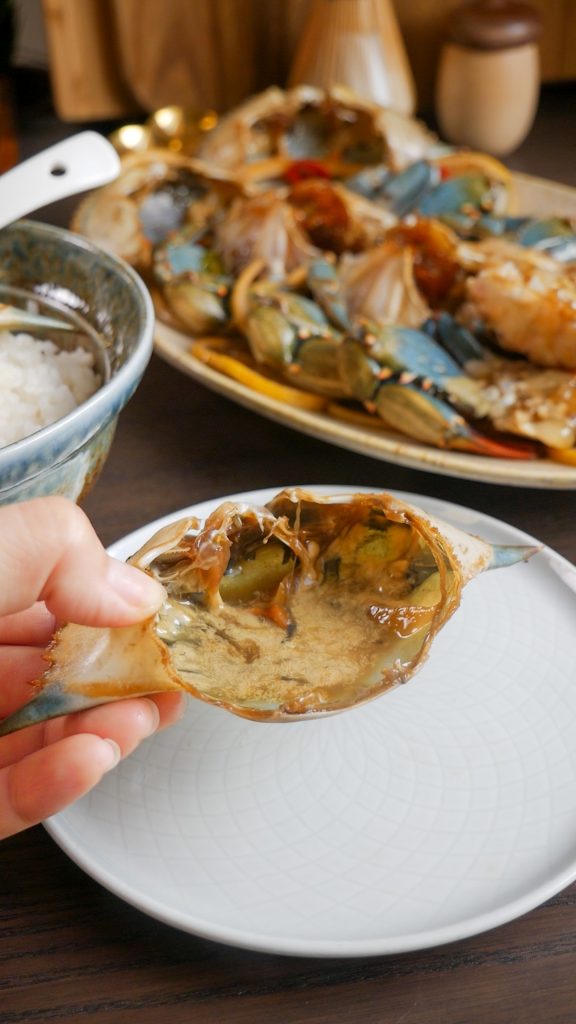
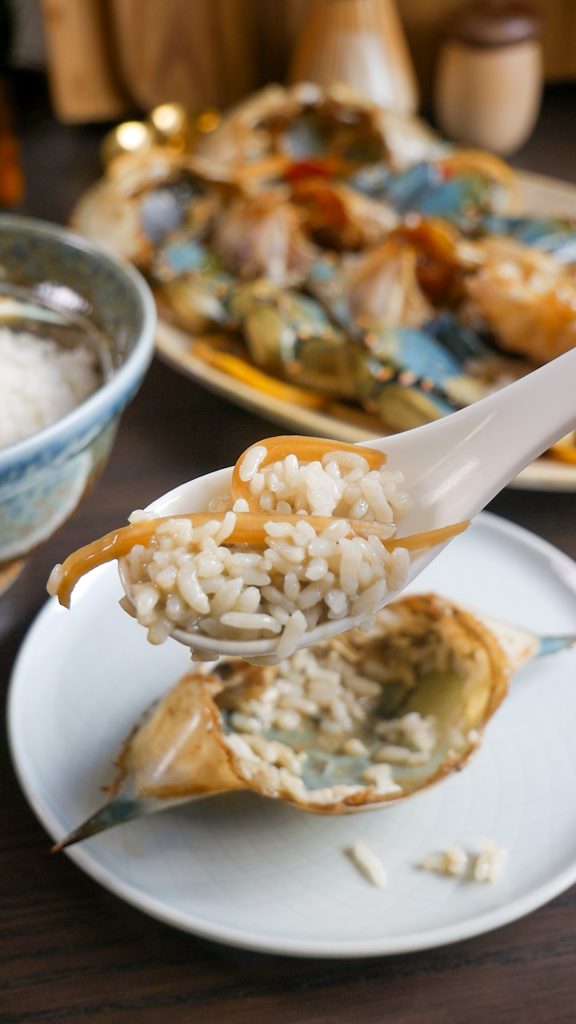
To serve, transfer the crab onto a plate along with the garnishes (the onions are my favorite!). Enjoy with a bowl of freshly cooked rice.
Preparation Tips for Soy Marinated Raw Crab
- It’s very important to use the freshest crabs you can find. The crabs should be lively, which indicates that it’s fresh. Avoid crabs that are sluggish and weak.
- Place the crabs in your freezer for 2 to 3 hours to make the cleaning and prepping process easier. This will put them to sleep and is the most humane way to process them. Keep in mind that the crabs should not be kept in the freezer for any longer than 3 hours because it will kill the crab. Dead crabs will begin decomposing and releasing bacteria that can make you ill.
- Be sure to clean the crab thoroughly! Use a soft bristle brush to scrub the grime in the crevices and trim the gills, mouth, and tips of the legs.
- Don’t forget to crack the crab claws! They have a significant amount of meat and you don’t want to let that go to waste.
Frequently Asked Questions
Is ganjang gejang raw?
Technically, ganjang gejang is raw because the crab doesn’t go through a cooking process. However, it is cured due to the marinade’s high sodium content which helps to preserve the crab.
Is it safe to eat Korean marinated raw crab?
Like with all raw foods, there is an inherent risk however, based on my personal experience, I’ve never had any issues. With that being said, it’s important that you use live crabs or frozen ones that have already been processed (cleaned and gutted), from a reliable source. You never want to use dead crabs because they deteriorate and spoil rather quickly which can lead to foodborne illnesses. Be sure to eat raw seafood at your own risk and always consult with your doctor if you’re unsure!
What does soy marinated raw crab taste like?
Soy marinated raw crab or ‘ganjang gejang‘ is a unique combination of savory, sweet, and umami flavors. When first biting into the crab, you get a burst of brininess and sweetness from the crab meat that’s complemented by the rich and savory soy marinade. Texturally, the crab is tender, silky, and melts in your mouth. If you enjoy eating sushi or sashimi, soy marinated raw crab will be right up your alley!
Is ganjang gejang fishy?
If you use live blue crabs, the ganjang gejang should not have any fishy odors or taste. However, I do notice that the frozen crabs are more pungent and have a fishy aftertaste. For those reasons, I almost always try to use live blue crabs for raw crab recipes like this.
Can you use frozen crab for ganjang gejang?
Yes, absolutely! Using frozen crabs is not only more convenient since they are usually already cleaned, but they are available all year round! Keep in mind that their meat is usually softer than live crabs and they may have a fishy odor and taste.
How long does Ganjang Gejang last?
When stored properly in an airtight container, ganjang gejang will last for up to 4 to 5 days in the fridge. However, it’s important to check for freshness to ensure it hasn’t spoiled. Signs to look out for are unpleasant/off odors or unusual color changes. When in doubt, always throw it out!
Looking for more easy and delicious Korean-inspired recipes?
- Yubuchobap (Korean Inari Sushi) – Yubuchobap or Korean inari sushi is sweet and savory tofu pockets that are stuffed with seasoned rice and occasionally served with toppingsThese bite-sized pockets of deliciousness are one of those dishes that once you start, you can’t stop eating! I served mine with marinated salmon, quick pickled cucumbers, and mentaiko mayo.
- Marinated Salmon Sashimi (Yeoneojang) – ‘Yeoneojang‘ is a refreshing and delicious dish made with raw salmon that has been cured in a rich and savory soy marinade. Perfect with a bowl of rice!
- Bossam – Korean Boiled Pork Belly – Bossam or Korean boiled pork belly is a classic comfort dish made of tender succulent pork belly that is boiled in various seasonings and aromatics. It is cooked low and slow, resulting in a flavorful, tender, melt-in-your-mouth bite. Korean comfort food at its finest!
- Rose Tteokbokki – Often deemed as tteokbokki’s unique and modernized sister, this is creamy, smoky, and milder in spice that’s irresistibly tasty. The ‘rose’ comes from the creamy rosy pink-colored sauce which beautifully balances out the spiciness and savoriness of classic tteokbokki. It’s incredibly indulgent and the perfect treat-yourself-meal!
- Seafood Soondubu Jjigae – This seafood soft tofu stew or ‘haemul soondubu jjigae’ is the epitome of Korean comfort food. It’s a spicy, flavorful, umami-rich bubbling pot of stew served with soft tofu, assorted vegetables, and seafood like clams and squid!
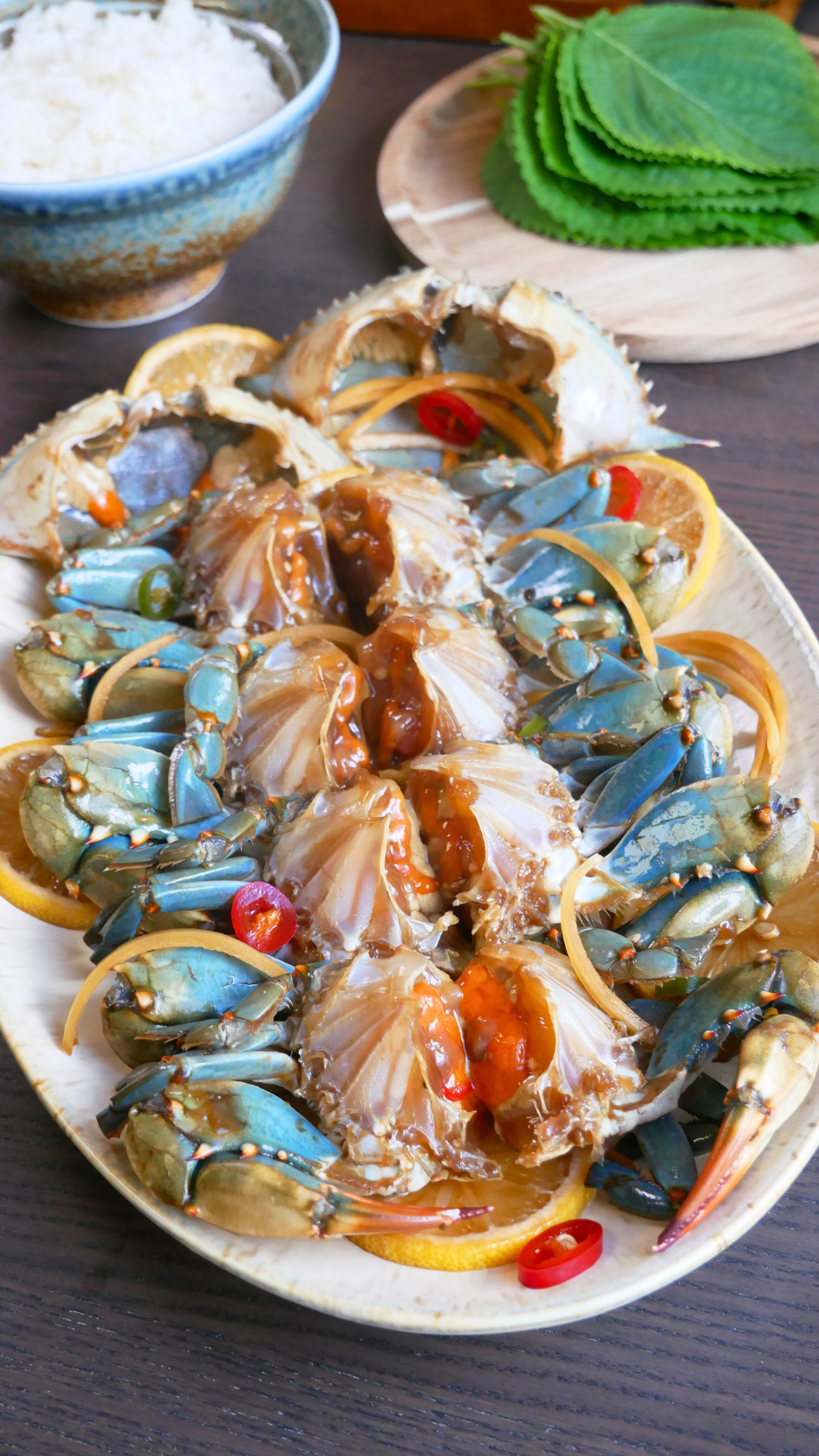
Soy Marinated Raw Crab – 간장게장 (Ganjang Gejang)
Ingredients
- 4 or 5 live blue crabs
- 1/4 cup soju substitute with sake or mirin (cooking wine)
Marinade
- 2 cups 2 cups soy sauce
- 1/2 cup 1/2 cup mirin
- 1/4 cup oligodang syrup substitute with rice syrup or sugar
- 1 small apple thinly sliced
- 1 small onion thinly sliced
- 1 scallion cut into 2 inch pieces
- 6 garlic cloves
- 1 tbsp ginger sliced
- 1 cheongyang pepper chopped, substitute with jalapeno or serrano peppers
- 2 small dried red chili peppers
- 1/4 tsp whole black peppercorns about 10 peppercorns
- 4 dried kelp 2×2 inch pieces
- 6 cups water
Garnish
- 1 cheongyang pepper chopped, substitute with jalapeno or serrano peppers
- 1 red chili pepper chopped, optional
- 1/4 onion thinly sliced
- 1/2 lemon sliced
Instructions
- Put the the live blue crabs to sleep by placing them into the freezer for 2 to 4 hours. This step will make the cleaning and preparation process easier.
- In the meantime, prepare the marinade. To a medium-sized pot, combine soy sauce, mirin, oligodang syrup, apple, onion, scallion, garlic cloves, ginger, cheongyang pepper, dried red chili peppers, whole black peppercorns, dried kelp, and water.
- Bring to a boil over high-heat then reduce the heat to medium. Simmer for 30 minutes then remove from the heat to cool completely. Once the marinade has cooled, strain then set aside.
- To clean and process the crab, flip the crab so the underside is facing up. Pull the apron back then twist to remove it. Rinse the crab under cold running water then use a soft bristle brush to scrub away any dirt and debris. Due to the nature of the crab's environment, they're quite dirty so make sure to get into the crevices and thoroughly scrub as best as you can (including the legs!).
- With the crab upright and facing you, place the non-dominant hand on one side the legs and use the dominant hand to pull back the shell. Don't toss the shell – we'll come back to this.
- Using kitchen shears, trim away the gills, mouth, and tips of the legs. The claws have a generous amount of meat so don't let them go to waste! Use a crab cracker to crack the legs which will allow the marinade to seep in. Once cleaned, cut the crab in half down the middle then repeat for the remaining crab.
- Take the crab shell and peel/scrape away the black film with your fingers. Be sure not to peel away the crab fat and roe – it's the best part!
- Place the crab in a deep tray or bowl then soak in soju for 10 to 15 minutes.
- Arrange the crab in a container with an air-tight lid. Top with the garnishes – cheongyang pepper, red chili pepper, onion and lemon.
- Pour the chilled marinade over the crab until completely submerged. Place the crab shells upright, making sure they're submerged as well.
- Cover with an air-tight lid then transfer to the fridge. Marinate for at least 24 hours or up to 48 hours.
- To serve, transfer the crab onto a plate along with the garnishes (the onions are my favorite!).
- Enjoy with a bowl of freshly cooked rice.